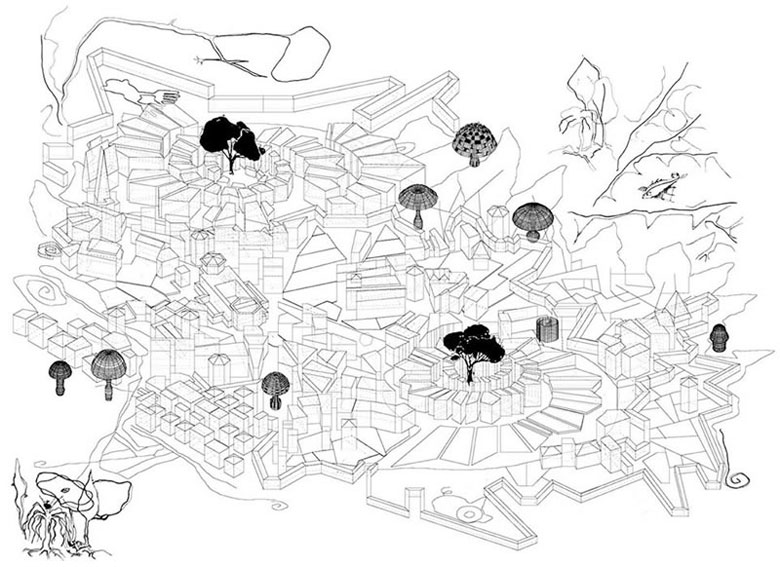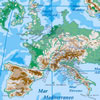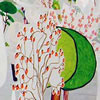| home rebecca agnes | books | texts | links | bio | cv |
Serie di 10 differenti città. Stampa digitale su carta montata su forex, disegni a pennarello. Ognuna di 100 x 150cm, 2003. Tramite un software cad per il disegno architettonico ho realizzato delle piante in alzato di dieci città, ognuna pensata per una persona diversa. Ho tentato di dar forma alla città ideale in cui vivrebbe la persona in questione. Una volta stampate le città su carta le ho mostrate a tutte le persone a cui sono dedicate. Ho chiesto a ognuno di loro di intervenire sulla propria città aggiungendo tutto quello che io non ho messo, ma che la persona ritiene indispensabile che ci sia, oppure modificando la città stessa. |
A series of 10 different cities. Digital print on paper, on forex, felt pen drawings. Each 100 x 150cm, 2003. Città consists of ten maps of unreal, hypothetical cities. They reflect the personality and the dreams of the ten people to whom these maps are dedicated and by whom they were inspired. Portraits through places, drawn with an architectural computer program. In a second phase the “owner” of each city takes part by drawing directly on the map with a felt-pen whatever they felt was missing. |
 |
la città di mary Stampa digitale montata su forex, interventi a pennarello,100 x 150cm, 2003. La Città di Mary è sospesa nell’aria. Non appoggia sulla superficie, ma è una città fluttuante. La sua pianta richiama le geometrie dei cerchi nel grano (crop circles). Gli edifici seguono una partizione geometrica che dal centro della città si dirama, allargandosi, verso il bordo, a spicchi. E’ caratterizzata da aree verdi circolari e giardinetti adibiti all’ospitare varie specie di animali. In alcuni di questi giardini sono presenti cucce per cani di varie dimensioni. Fra gli edifici vi è un osservatorio astronomico ed un anfiteatro per concerti. In questa città vi sono dei buchi nella pavimentazione, in cui è possibile cadere e precipitare nel vuoto. |
mary's city Digital print mounted on forex, markers, 100 x 150cm, 2003. Mary's city is suspended mid air. It doesn't rest on the ground, it is a floating city. Its plan recalls the geometry of crop circles. The buildings follow a geometrical partition that branches out from the center of the town, widening towards the borders, in segments. It is characterized by circular green areas and little gardens that shelter numerous animals. In some of these gardens there are doghouses of various sizes. Among the buildings there is an astronomical observatory and an ''amphitheatre'' for concerts. In this city there are holes in the ground, in which one can fall and plunge into a void. |
 |
la città di matty Stampa digitale montata su forex, interventi a pennarello,100 x 150cm, 2003. La Città di Matty si trova in una campagna fatata ed irreale. La sua struttura è organizzata attorno a due complessi architettonici la cui disposizione richiama quella di un nautilus, rispettivamente a sud e a nord. La sua disposizione è trasversale e i suoi edifici sono circondati da mura irregolari dagli angoli vivi. Le costruzioni presenti più curiose sono degli enormi edifici la cui struttura richiama quella dei funghi. |
matty's city Digital print mounted on forex, markers, 100 x 150cm, 2003. Matty's city is in a fairy and surreal countryside. Its structure is organized around two architectural complexes whose arrangement is similar to a nautilus, to the north and to the south respectively. Its arrangement is transverse and the buildings are surrounded by irregular walls and sharp corners. The most peculiar ones are enormous buildings whose structure reminds of mushrooms. |
“Le Città che Ci Aspettano” è il titolo di una antologia di fantascienza americana edita per la prima volta in Italia da Urania nel 1974. Il titolo originale dell’opera è “Future City” (a cura di Roger Elwood, 1973). Il senso dei due titoli differisce come accade spesso nelle traduzioni di titoli di film e libri. La traduzione finisce per indicare qualcosa di diverso dall’originale. Il problema è sempre nella traduzione e nella impossibilità della stessa. “Le Città che Ci Aspettano” è quindi un’antologia in cui (come indicato dal titolo) il denominatore comune dei vari racconti è che tutti riflettono all’interno delle proprie tematiche fantascientifiche il tema della città. Il titolo è quello che mi ha attirato di questa antologia, trovata ad un euro su una bancarella del libro usato in questo mese di novembre, in cui insieme al progetto delle “mie città” dovevo anche trovare un titolo a questa mostra e dovevo pure distanziarmi dalle città invisibili che ogni giorno venivano a scuotermi, ricordandomi quanto esse sono state (e sono?) presenti nel mio lavoro. Ipazia, Leandria, Cloe tentavano sempre di infiltrarsi nei miei pensieri, e a niente valeva ricordargli che io già le avevo collocate nella mia “Mappa” e che quindi era ora di prenderci un po' di respiro. Parlando con le persone a cui sono dedicate le “Città” una delle cose che si sta delineando è il fatto che esse vengano prese in parte come una soluzione “se io abitassi qui, tutto sarebbe risolto” è stata una frase che è divenuta inaspettatamente parte del lavoro, che io, però, non avevo contemplato prima. Perché si, ho tentato di progettare qualcosa fatto su misura per ognuna di queste 10 persone, ma allo stesso tempo la città era lo specchio in cui rifletterle, in cui rivederle in forma di “ritratto” concreto e della superficie, era un po' come la casa in cui si abita, o i vestiti che si indossano o i libri che si leggono. Il tutto occhieggiando al fatto che comunque queste città nascono dalla mia idea e visione che ho di queste 10 persone, e che è quindi tacciabile di imprecisione, manchevolezza oppure travisamenti e interpretazioni soggettive. Un altro problema nel dare un titolo ad una mostra che ruota attorno a 3 differenti lavori complementari è quello di riassumere quello che capiterà nello spazio di Viafarini senza evidenziarne un unico aspetto. E qui mi è venuto incontro il titolo di questa antologia ingiallita ed impopolare. Perché in se per se non indica esattamente i lavori, che comunque hanno tre titoli propri e distinti...e allo stesso tempo si collega di rimando al titolo di uno dei tre. “Il Giardino Sospeso” se da una parte è un tentativo di catalogazione delle varie specie di alberi, di enciclopedia delle mie relazioni, di antologia a sua volta sospesa fra rappresentazione del segno, dell’albero e dell’individualità che ha scelto l’albero, e che lo ha ricreato secondo il proprio personale codice, dall’altro canto prende il proprio titolo da un mio errore di traduzione di cui non mi sono resa conto fino a poco tempo fa. Difatti il giardino sospeso è “The Hanging Garden” dei The Cure (“Pornography” 1982). Ascoltando questa canzone ho sempre inavvertitamente tradotto quel hanging come appeso/ sospeso, senza mai realizzare che la traduzione corretta è giardino pensile. Così ho sempre caricato questo titolo di un intento immaginario e poetico senza rendermene conto. Così il mio errore di traduzione ha trasfigurato il titolo di una canzone in qualcosa che non le apparteneva. La canzone è sempre bellissima, ma ora è una canzone diversa da quella che ho ascoltato per tanti anni. E così l’elemento unificatore di questa mostra è la transizione immaginaria e concreta dei processi presenti nell’ esecuzione di ognuno dei tre lavori. La partenza è una richiesta, una raccolta di materiale che non posso controllare fino in fondo, in cui gli interventi di altri si inseriscono nelle mie architetture, oppure è dai loro interventi che io costruisco. E poi perché le città non aspettano noi, le città non aspettano nessuno. Aspettano e basta. |
''Le Città che Ci Aspettano'' is the Italian title of a science fiction anthology first published in Italy by Urania in 1974. The original title of the work is ''Future City'' ( edited by Roger Elwood, 1973). The meaning of the two titles differs, as often happens in the translation of movies and books' titles. The translation ends up indicating something different from the original. The problem always lies in translation and in its impossibility. Therefore ''Le Città che Ci Aspettano'' is an anthology in which (as indicated by the title) the leitmotif of all the short stories is that they reflect -within their own science fiction themes- the topic of the city. The title is what drew me to this anthology, bought at the price of one euro from a second hand bookstall in November, month during which -together with the project my ‘'città''- I had to find a name for this exhibition and I also felt compelled to distance myself from the invisible cities that haunted me every day, reminding me of much they had been (and still are?) present in my works. Ipazia, Leandria and Cloe constantly tried to penetrate my thoughts, and it was no use to remind them that I had already collocated them in my ''Map'' and that it was time to take a break from one another. One of the things that emerges from talking to the people to whom I have dedicated the ''Città'' is the fact that they are partially considered as a solution. ''If I lived here, everything would be ok'' is a sentence that has unexpectedly become part of the work, although I hadn't really contemplated it before. Yes, I have tried to plan something ''custom-made'' for each of these 10 persons, but at the same time the city was the mirror in which to reflect them, in which they could be seen as a concrete ''portrait'' of the surface, it was a bit like the house one lives in or the clothes one wears or the books one reads. All this eyeing up the fact that these cities are born from the personal idea and vision I have of these 10 persons, hence chargeable with inaccuracy, faultiness, misrepresentations and again subjective interpretations. |
 |
PREVIOUS | NEXT |  |
| home rebecca agnes | books | texts | links | bio | cv |